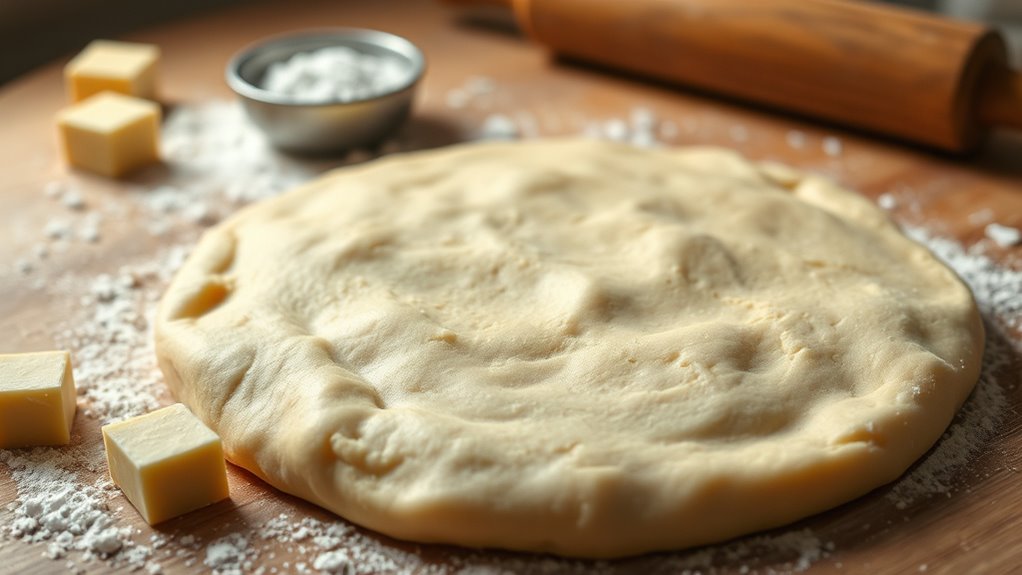To make the perfect pie dough, mix 1 ½ cups of your chosen flour with a pinch of salt. Cut in ½ cup of cold, unsalted butter until it resembles coarse crumbs, then gradually add ice water until the dough forms. Shape it into a disc, wrap it in plastic, and chill for at least an hour. Roll it out and fit it snugly into your pie dish. Curious about more tips for that perfect crust?
Ingredients and Quantity
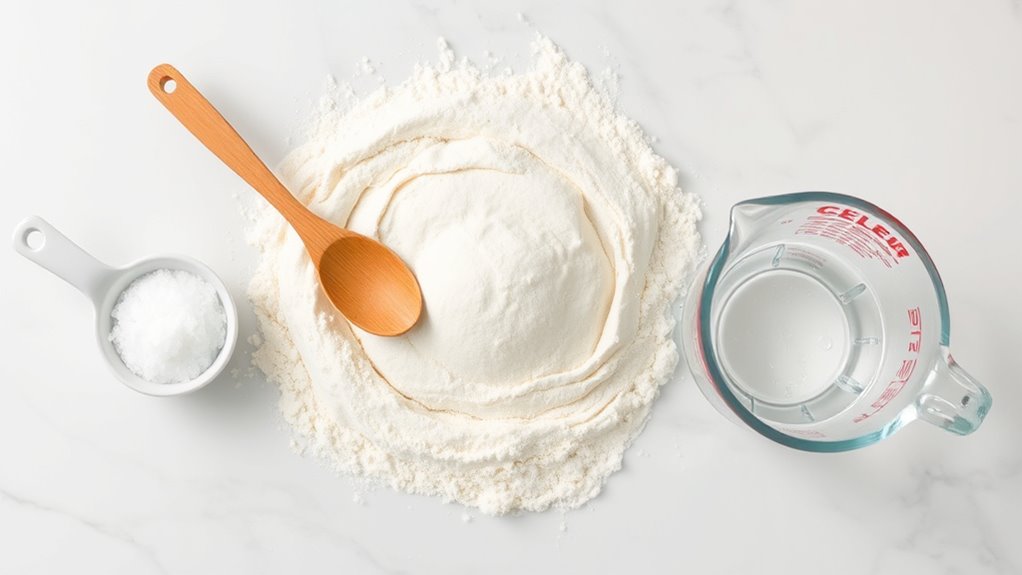
When it comes to crafting the perfect pie dough, the right ingredients are essential for achieving that flaky, tender crust you crave. Choosing the best flour types and butter options can greatly impact your results. Here’s a quick guide to help you decide:
| Flour Type | Best For | Protein Content |
|---|---|---|
| All-Purpose Flour | Versatile pies | 10-12% |
| Pastry Flour | Delicate pastries | 8-10% |
| Whole Wheat Flour | Nutty flavor pies | 13-15% |
| Butter Option | Flavor Profile | Recommended Use |
| Unsalted Butter | Rich, creamy taste | All pies |
| Lard | Flaky, tender crust | Traditional pies |
Experimenting with these choices gives you the freedom to create your ideal pie!
Preparations
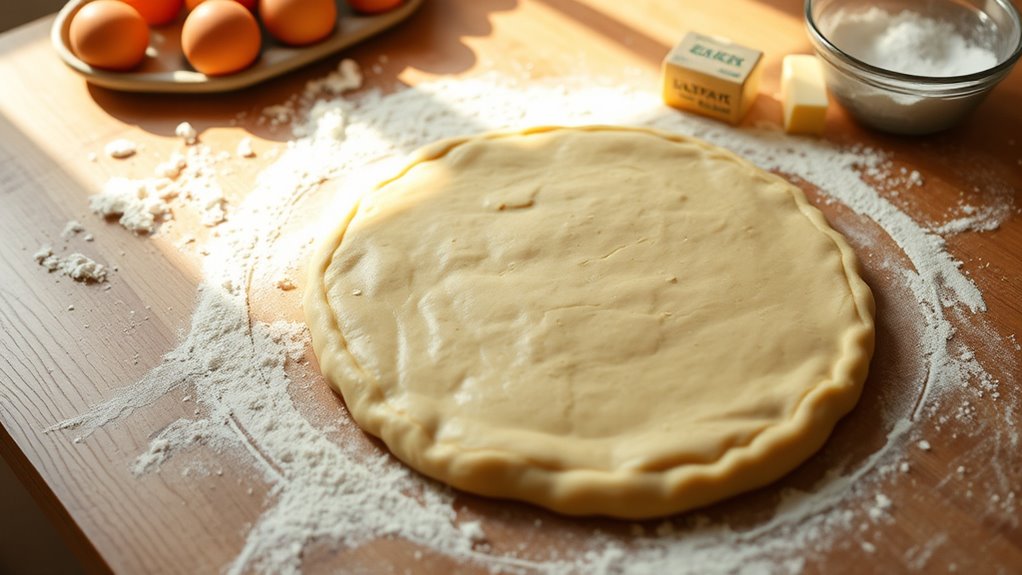
With the right ingredients in hand, you’re ready to prepare your pie dough. Start by mixing your flour and salt in a bowl, then cut in your cold butter until the mixture resembles coarse crumbs. This step’s essential for achieving the perfect dough consistency—light and flaky. Gradually add ice water, one tablespoon at a time, until the dough comes together. Don’t overwork it; you want to maintain that tender texture. If you’re feeling adventurous, consider flavor variations like adding a hint of vanilla or a sprinkle of cinnamon. Once your dough is formed, shape it into a disc, wrap it in plastic, and refrigerate for at least an hour. This will enhance the flavors and make rolling easier!
Tools / Kitchenware Required
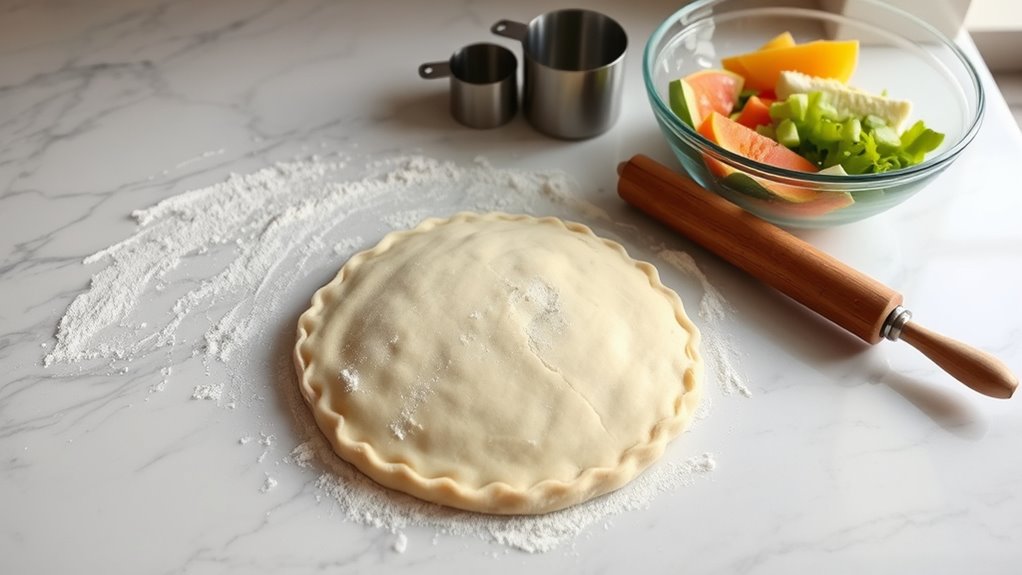
To create the perfect pie dough, you’ll need a few essential tools that can make the process smoother and more enjoyable. A good rolling pin is key for rolling out your dough evenly, while a pastry cutter helps you blend your ingredients seamlessly, guaranteeing that your dough has that light, flaky texture. Here’s a handy table of the must-have tools:
| Tool | Purpose | Tips |
|---|---|---|
| Rolling Pin | Rolls out dough to your desired thickness | Use a floured surface |
| Pastry Cutter | Cuts butter into flour efficiently | Keep it chilled for best results |
| Mixing Bowl | Combines ingredients | Choose a large bowl |
| Measuring Cups | Guarantees accuracy in measurements | Use dry and liquid sets |
| Plastic Wrap | Covers dough for chilling | Make it airtight |
With these tools, you’re well on your way to pie perfection!
How to Cook
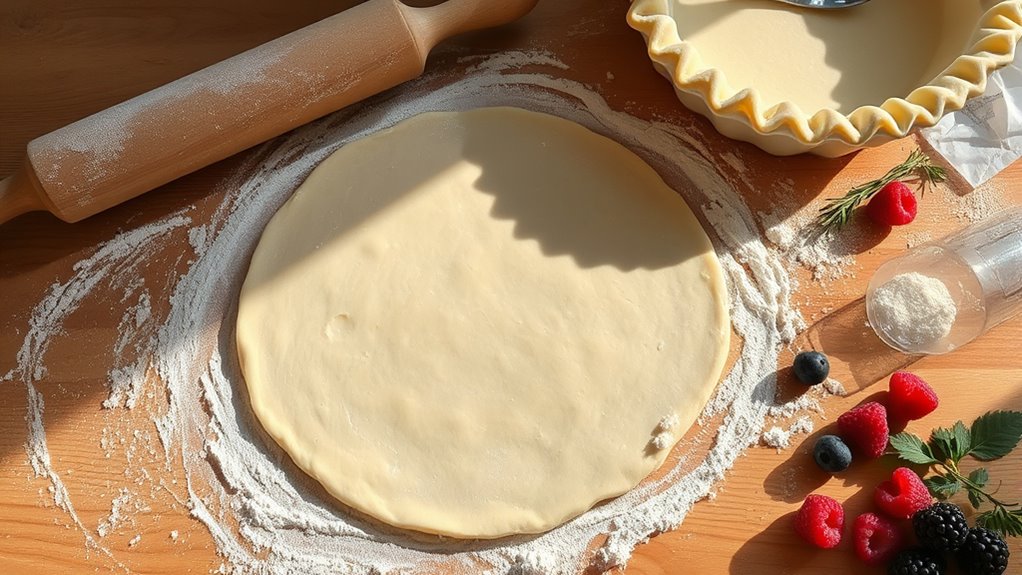
- Roll out your chilled pie dough on a floured surface into a perfect circle.
- Use gentle pressure to avoid tearing the dough.
- Transfer the dough to your pie dish, ensuring it fits snugly.
- Trim any excess dough from the edges.
- Crimp the edges for a classic decorative touch.
- Pre-bake the crust to prevent a soggy bottom.
- Cover the edges with foil if they brown too quickly during baking.
- Fill the crust with your chosen ingredients.
- Cook using various methods based on your recipe.
- Enjoy your perfectly baked pie, whether sweet or savory!
How to Serve
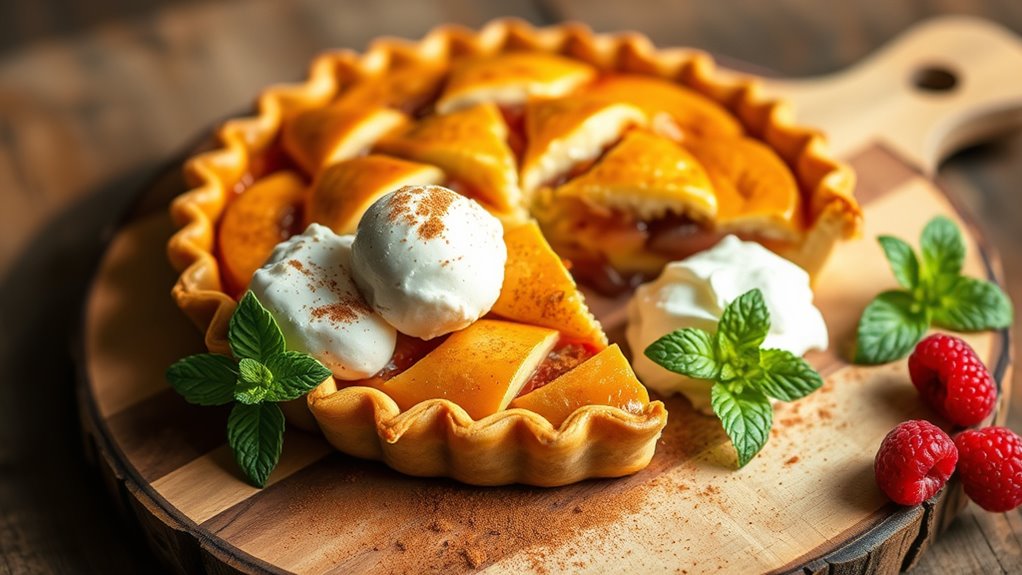
Once your pie is baked to golden perfection and cooled slightly, it’s time to think about how to serve it up. Start by slicing into perfectly even wedges; you want each piece to look inviting. For serving suggestions, consider a scoop of vanilla ice cream or a dollop of freshly whipped cream on top—both are crowd-pleasers. You might also sprinkle a bit of cinnamon or nutmeg for an aromatic twist.
When it comes to presentation ideas, a rustic wooden board or a simple white plate can enhance your pie’s appeal. Garnish with fresh fruit or mint leaves for a pop of color. Remember, how you serve it can elevate the experience, inviting everyone to indulge in your delicious creation!
Tips
While perfecting your pie dough can seem challenging, a few simple tips can make the process smoother and more enjoyable. Embrace these baking techniques to elevate your pie crust to new heights:
- Keep it cold: Use chilled butter and ice water to maintain a flaky texture.
- Don’t overwork: Mix just until combined; over-kneading can lead to tough dough.
- Resting is critical: Let your dough chill in the fridge for at least 30 minutes to relax the gluten.
- Use a light touch: Roll out your dough gently to avoid stretching and tearing.
With these tips, you’ll be well on your way to creating a perfect pie crust that’ll impress everyone at your next gathering! Enjoy the freedom of experimenting in your kitchen.
Food Value and Benefit
Pie dough, when prepared thoughtfully, serves as a delicious base for your favorite desserts while providing valuable nutrients. Depending on the ingredients used, especially whole grain flours and healthy fats, pie dough can contribute to a balanced diet.
Thoughtfully prepared pie dough offers a delicious base for desserts while adding valuable nutrients to your diet.
Nutritional Value of Prepared Pie Dough:
- Provides carbohydrates for energy.
- Contains dietary fiber (especially when made with whole grain flour) that supports digestive health.
- Supplies fats from butter or oil, offering essential fatty acids important for heart health.
- Contains small amounts of protein.
- Vitamins and minerals present include Vitamin E, Vitamin B-complex (such as B1, B3, and B6), iron, magnesium, and zinc.
Benefits of Eating This Recipe:
- Supports digestion: Fiber aids in maintaining healthy bowel movements and prolonged satiety.
- Heart health: Essential fatty acids and Vitamin E help reduce inflammation and support cardiovascular function.
- Energy supply: Carbohydrates provide a quick and sustained source of energy.
- Mineral contribution: Iron supports oxygen transport in the blood, while magnesium and zinc play roles in immune function and metabolism.
- Versatility for dietary needs: Using alternative flours like almond or gluten-free options can accommodate gluten sensitivities and provide additional nutrients such as healthy fats and protein.
Frequently Asked Questions
Can I Use Gluten-Free Flour for Pie Dough?
Absolutely, you can use gluten-free flour for pie dough! Just keep in mind that gluten-free options can alter the pie dough texture; it might be a bit crumbly. To achieve a better consistency, consider adding a binding agent like xanthan gum or using a blend of gluten-free flours. Experimenting with ratios can help you find that perfect balance. With a little creativity, you’ll be enjoying delicious, gluten-free pies in no time!
How Can I Prevent My Pie Crust From Shrinking?
To prevent your pie crust from shrinking, make sure you’re chilling the dough thoroughly before rolling it out. When you roll it, use gentle, even pressure to avoid stretching it too much. If you notice any shrinkage during baking, consider using a pie shield to protect the edges. It’s all about keeping the dough relaxed and giving it the freedom to maintain its shape while it bakes to perfection. Enjoy your baking!
What’s the Best Way to Store Leftover Pie Dough?
To store leftover pie dough, wrap it tightly in plastic wrap or place it in an airtight container. This keeps moisture in and prevents it from drying out. For ideal freshness, you should refrigerate it for up to three days. If you need longer storage, consider freezing it. Just make sure to label it with the date. When you’re ready to use it, let it thaw in the fridge overnight. Enjoy!
How Long Can I Keep Pie Dough in the Freezer?
You can keep your pie dough in the freezer for up to three months, preserving that buttery, flaky goodness. Imagine pulling out a perfectly wrapped, frozen disk of dough, ready to transform your kitchen into a haven of warmth and delicious aromas. Use pie preservation tips like wrapping it tightly in plastic wrap and placing it in an airtight container. Master these freezing techniques, and you’ll always have a delightful treat at your fingertips!
Can I Add Flavorings to My Pie Dough?
Absolutely, you can add flavorings to your pie dough! Enhancing pie dough with ingredients like vanilla extract, citrus zest, or spices can elevate your crust to new heights. Just remember to balance the flavors so they complement the filling. A touch of almond extract or a sprinkle of cinnamon can make a delightful difference. Experimenting with these pie dough flavorings gives you the freedom to create something uniquely yours, so don’t hold back!
